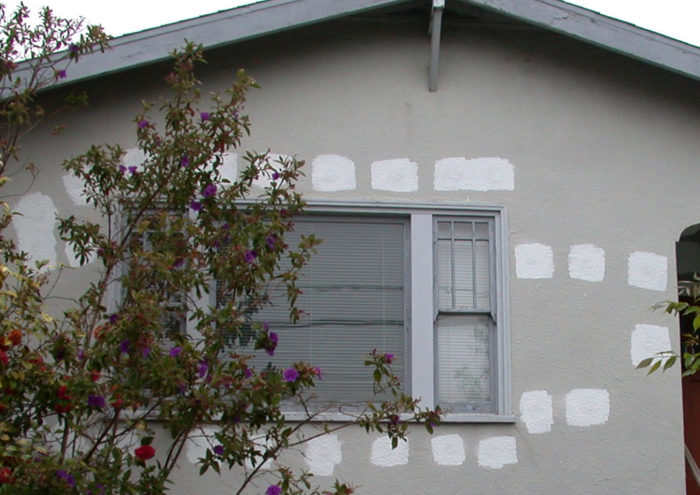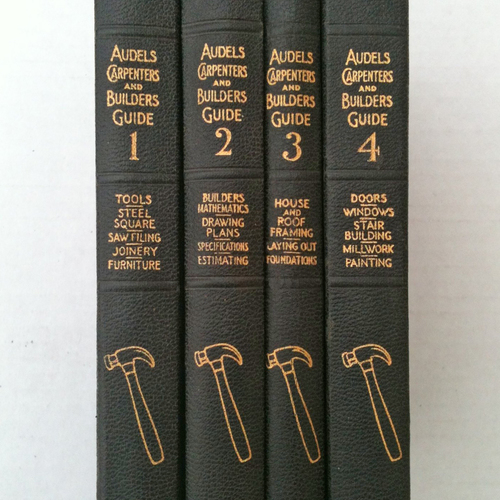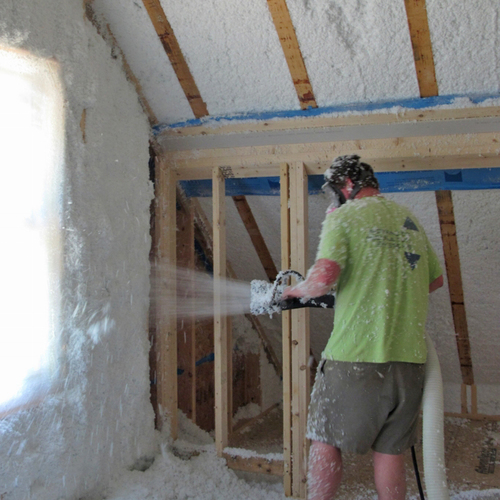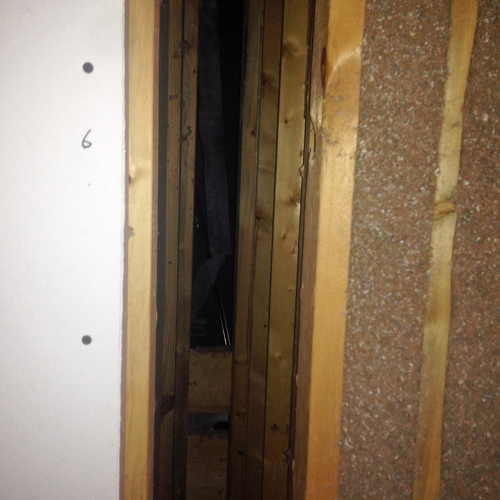Image Credit: All photos: Alana Shindler
Working at Home Energy magazine would seem to have prepared me for having an energy-efficiency retrofit done on my own home, or at least to ask all the right questions. But Murphy’s Law intruded nevertheless, and you may learn from my experience.
We live in the San Francisco Bay Area in a 970-sq. ft. wood-framed stucco single-family home on one floor over a basement and garage, with central heat but no air conditioning. Our goal for the audit was to improve comfort, as hot days were hotter inside the house, and cool days were downright cold. The attic already had some insulation, but the walls and floors did not.
We agree to have our house insulated
After meeting with the salesman from an energy efficiency company, completing the audit, and receiving the quote, we decided to go ahead with adding insulation to the attic to a value of R-38, and insulating the walls. Although the company also recommended insulating the floor, we decided to hold off on that because of limited funds and because our basement has always seemed warm year-round.
Since we were also planning to paint the exterior of the home, it was recommended to us that the best approach to insulate our walls would be to bore multiple small holes in the exterior stucco instead of into the interior walls, a much more intrusive method which would create dust in our living space. It made a lot of sense as I have allergies, and thus my relief at being offered this solution distracted me from asking if there might be any downside to this method. They assured us the holes would be small and they would be patched up for the painters. I checked with the painters and they concurred, as they had seen such holes in the past.
We discussed my windows and doors, and though new windows were offered to me, I knew enough not to replace my historically appropriate, single-paned original wooden bungalow windows as they were in decent shape and could be weatherized.
Noise and dust
The insulation was begun while I was at work a few weeks later. I returned home to find a very unhappy spouse who said that the noise had been unbearable, and he and the dog had gone out several times during the day to escape, but had still borne the brunt of it inside the house. The drilling continued for several days, during which some dinnerware broke due to the vibrations of our kitchen wall cabinets. I did come home for some of it and couldn’t believe the decibels.
I wondered why we had not been given a heads-up about the noise and the vibrations so we could have made plans to be elsewhere. Also, dust did appear mysteriously inside the house which we were able to vacuum up each day.
Patching problems
Relieved when the noisy hole-boring and the insulation-blowing into the walls were completed, the last phase was the stucco patching in blessed silence. When completed, the concave stucco patches looked awful. I called to ask that the workers come back to level them, as the painters were not responsible for that. One or two guys appeared every day for a number of days to level the patches on the innumerable holes, which they did but without matching the texture of the rest of the stucco.
I hoped that the painting would successfully conceal the textural differences, but after the new paint job, all I could see were the circular patches all over the house. The energy efficiency company workers did their best but were unskilled in stucco application.
I called an independent stucco guy who came out to the house for his opinion. He said if he had a dollar for every time he’s been called to look at the unsuccessful finish work done to stucco by insulators, he’d be a rich man. He said there was nothing to be done, and that comparatively speaking, it was a lot better than some he’d seen.
I was appalled after spending so much money on the new paint job, but felt I had no redress. I blamed myself for not thinking it all through ahead of time. Since then I have learned not to focus on the imperfections in the stucco: I’m sure they’re still there, but I’ve learned to not see them.
Advice for home-performance contractors
As a result of my experience, I have three recommendations for energy efficiency companies, and all of them involve communication.
ONE: Give residents fair warning ahead of time about any negative impacts the work will have on people and animals in the space so they can make plans to deal with it.
TWO: Have a working partnership with stucco experts for those times when exterior hole-boring is the way to go; or at least recommend to the homeowner from the start that they find such an expert and get a quote to do the patching so that the holes can be filled to the optimal effect. If the industry is going to take a “whole house” approach to energy efficiency, the least the contractor can do is to consider the whole house from the perspective of the customer and not just the part he is concerned with.
THREE: Have the salesman call the customer when the work is completed to check in to see that the customer is satisfied. We never saw the nice salesperson again in our home, although someone did come back to do infrared tests to see that the walls were filled properly, and I believe the blower-door test was repeated.
Our house is more comfortable
We have noticed a big difference in our comfort levels which was the outcome we had desired. Interestingly, we recently refinanced the house and our appraisal report showed no increase in value from improving our home’s energy efficiency, despite pointing out to the appraiser the insulated walls, attic, new highly efficient can lights in the kitchen and window reconditioning by our local master window restoration specialist. ZERO $!
Perhaps it’s because we live in a temperate zone…or the appraiser thought that a new granite countertop in the kitchen would have had a REAL impact on value, I don’t know. Hopefully when it is time to sell the house, its energy efficiency value will rise to the fore. I shared with the appraiser that our electric bills are generally about $30 to $35/mo, and our gas bills from $15 to $25 depending upon the season. The appraiser revealed that his own house, more than twice the size of ours a few miles away cost about $300 a month for gas and electric utilities. Apparently several professions could use more education on energy upgrades!
Alana Shindler is the fulfillment manager at Home Energy magazine. Her blog originally appeared on the Home Energy website and is reprinted with her permission.
Weekly Newsletter
Get building science and energy efficiency advice, plus special offers, in your inbox.















4 Comments
Good piece, hire a GC
All points that should apply to any type of contractor. But it's also a reason to hire a general contractor instead of a specialty sub. We do a lot of weatherization work, both in-house and with subs. We know how to do dust control, we know what to warn clients about, and we know where to find the other subs to do the job right. It's not unreasonable to expect a weatherization company to know how to patch the holes they make, but as you discovered they have a limited skill set.
And on the appraisal front, let's hope the proposed SAVE act passes and has some effect.
Great reminder
As a general contractor who does weatherization retrofits, we have had great success with happy customers by doing these very things. While there's lots of great contractors out there doing great work, often what is missing is communication and simply cleaning up! Part of good communication is knowing when to bring in an outside expert (stucco installer in this case.)
I'm interested in other people's experience about what the contractors with satisfied customers are doing right.
Stucco should not be painted as it keeps the walls from breathing and letting out moisture. Drilling holes from the outside is not a great idea as it is difficult to impossible to repair the weather resistant membrane, which is usually tar paper on the inside.
Matching the stucco finish for a repair is not impossible but requires skill and practice. You can also texture the whole wall.
Instead of paint, do a ‘fog coat’ in your desired color, available from your masonry supply. It can be sprayed with a garden sprayer. Be sure to get your texture problem resolved first.
If your contractor cannot match the texture or doesn’t know what fog coat is, keep looking. Your masonry supply will know the names of contractors who buy these materials from them and can do the work.
Greg,
If by "breathing" you mean remain vapour-permeable then yes, but there are stucco paints which do that.
Log in or create an account to post a comment.
Sign up Log in